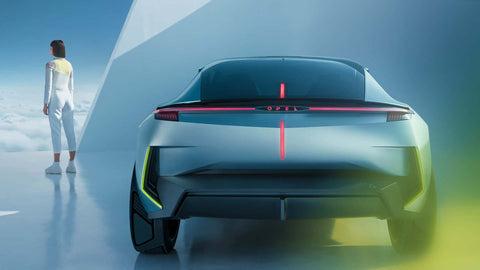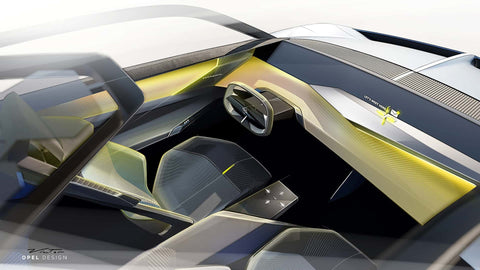The retractable steering wheel is only possible thanks to the steer-by-wire technology
Concept cars have always been the carmakers’ go-to method to showcase their philosophy, future technological possibilities and set the tone for their future car production criteria. Opel is no different, and being under the umbrella of the automotive giant Stellantis makes going on such technological adventures a lot easier.
Opel CEO Florian Huettl commented on the new concept by saying: “The Opel Experimental gives a glimpse of upcoming models and technologies, of future design, yes, of a new era and the future of the brand. This breathtaking concept vehicle points our way forward and once again shows Opel's pioneering spirit"
Before getting into all the fascinating bells and whistles, let’s skim through the major technical features of the Experimental. Opel disclosed that the concept will be based on what they called “the state-of-the-art Stellantis BEV platform” which most likely refers to the STLA platform that underpins most of Stellantis's new electric offerings.
Other details include all-wheel driving, dimensions that are similar to that of the Opel Grandland all-electric crossover, and most importantly, a steer-by-wire system, allowing for the integration of a foldable steering wheel; the main marketing feature for this concept car.
And finally, to avoid any aerodynamic issues that are typically associated with crossovers, Opel is experimenting with a new set of front and rear flaps and an automatically retractable rear diffuser. On the ground level, stability and energy efficiency are also reinforced with newly developed Goodyear tires that sit on three-zone Ronal wheels.
No Chrome Exterior, Only LED!
Throughout the years, we were conditioned to believe that all things “future” should be covered in chrome. Opel is challenging that idea with a new design approach that uses lighting elements and high-contrast graphics instead of chrome outlines to frame the car’s coupe crossover proportions.
So instead of a shiny logo, the car will have an illuminated Opel Blitz and compass. The light features then extend in the form of elongated headlights. This combination is mirrored with a similar design at the back as well.
The man behind the futuristic design, Opel design chief Mark Adams, described his and his team’s work by saying: “Our new Opel Experimental shows a more technical and even more pointed interpretation of our bold and clear design philosophy. With it, our vision of the future takes shape. Many of its design elements and the underlying philosophy will be reflected in future production models. The body design combines the best aerodynamics with an unmistakable silhouette. And the interior conveys an intense, emotional user experience,”
Space Detox – Finally, Some More Legroom!
Opel’s Experimental EV is baptized as a C-segment car, on the inside, however, the company claims that it has as much room as a D-segment vehicle.
How’s that possible?
Well, the retractable driving wheel certainly plays a role, but Opel made sure to declutter the interior space, by leaving only driving-necessary features and using slimmer lightweight seats. This entire process was coined “Space Detox” and it certainly makes the cabin look a lot bigger than it actually is.
Concerns may be raised about the quality and durability of such a futuristic interior. Real-world conditions and everyday use don’t really care about how fancy your interior looks, that’s why some seat covers and floor mats may come in handy even on such a high-end concept car.
More in line with the radical design mindset witnessed on the outside, side mirrors vanished entirely, and all you get with the Opel Experimental is a pair of 180 degrees cameras logged in the C-pillar. Opel is also doing away with conventional screens, or screens for that matter. The entire infotainment system is replaced by an augmented reality projection system that projects above the dashboard.
This will increase the focus on the dashboard, underscoring the importance of maintaining a clean and polished appearance. The most effective method to achieve this is by using custom-made dash covers.
Considering how this is just an experimental concept car, details about range or battery capacity were completely ignored by the carmaker. The main focus is naturally to see how some or, hopefully, all technological features can be carried over to future production models, rather than just obsessing with long-range.






